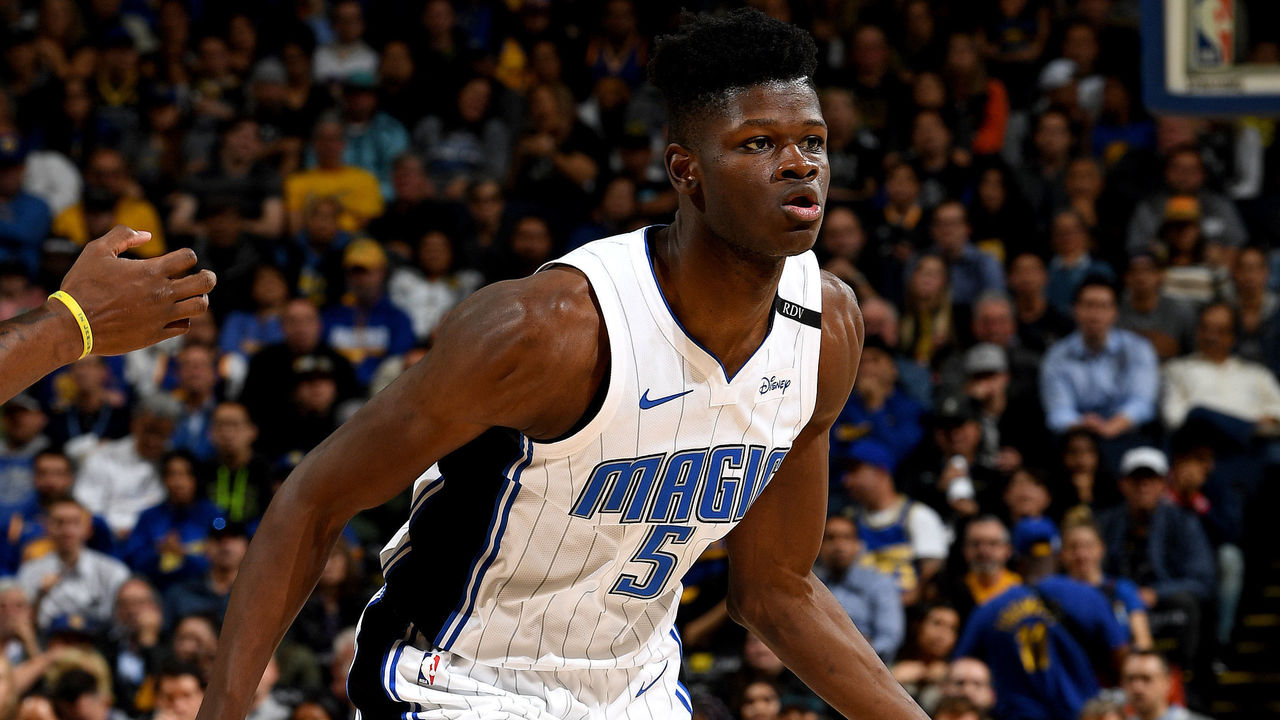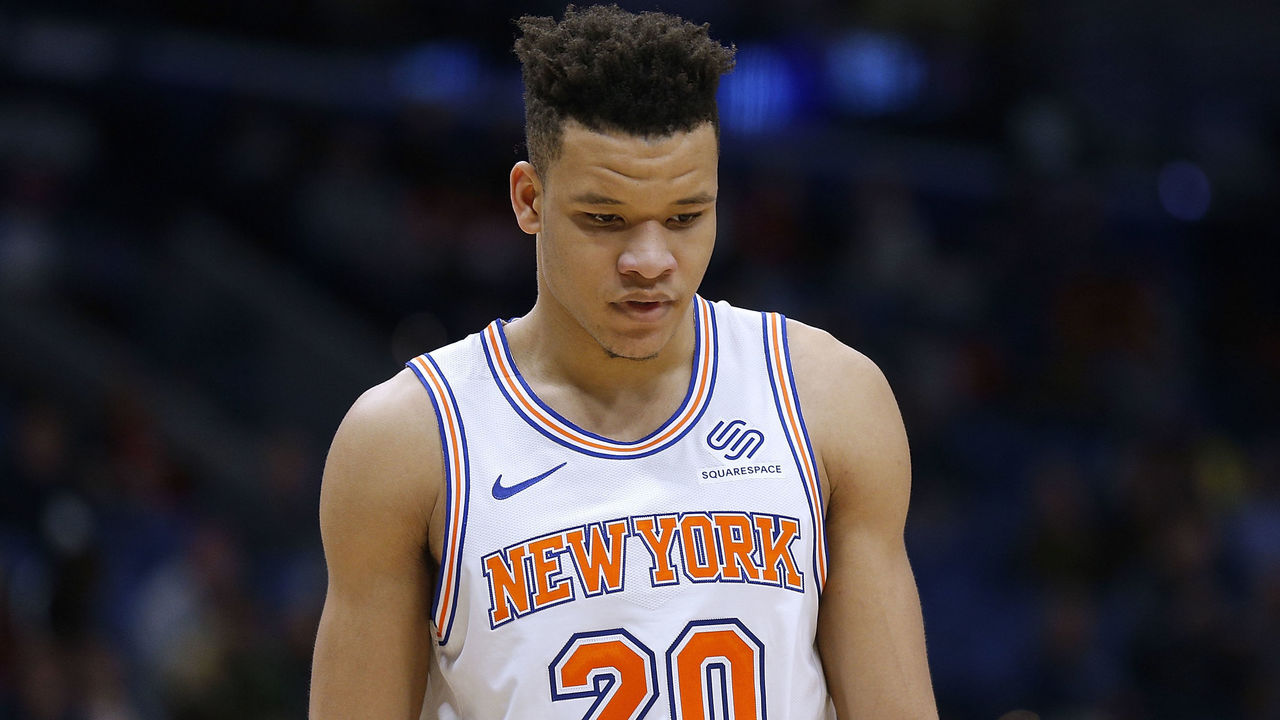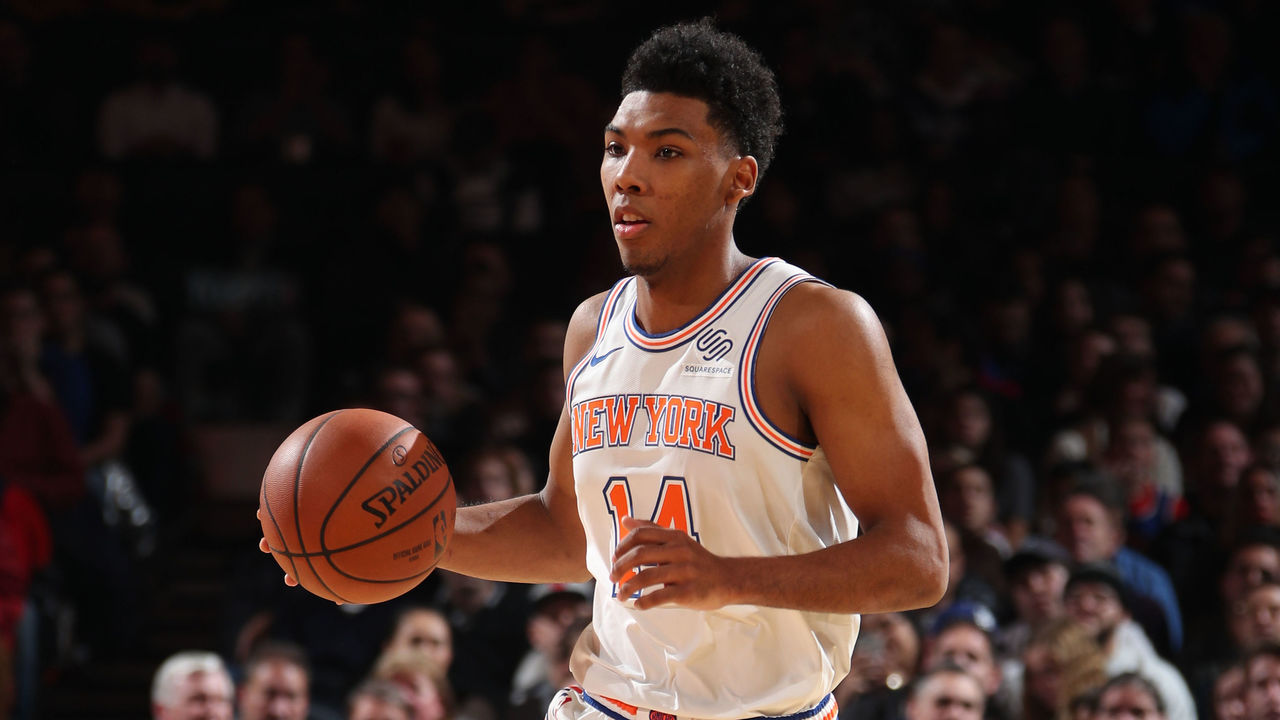Rookie Report Card 1.0: Luka Doncic as advertised, Jaren Jackson on fire
With more than a quarter of the season done, theScore draft experts William Lou and Wael Saghir evaluate the most notable members of the 2018 rookie class. Wael breaks down each player's skill set coming out of the draft, while Will grades their first two months in the NBA relative to expectations (draft position in parentheses).
C Deandre Ayton, Phoenix Suns (No. 1)
| PPG | RPG | FG% | Offense | Defense |
|---|---|---|---|---|
| 17.0 | 10.5 | 62.1 | A | B- |
Draft assessment: Few college athletes were as physically imposing as Ayton during his lone year at Arizona. Scouts expected the Bahamian to immediately impact an NBA offense, mixing his dominant post play with an effective mid-range jump shot. However, there were questions about how his defense would translate. He lacks the lateral quickness to help on switches and isn't the rim protector most would hope for.
NBA assessment: Ayton's delivered on expectations. He's an extremely coordinated 7-footer who finishes everything around the basket and he controls the glass on both ends. He can also stretch beyond the 3-point arc, shooting 45 percent from beyond 16 feet and 75 percent from the charity stripe. His focus should be improving his defense. Ayton frequently gets lost in pick-and-roll coverages, which is hardly uncommon for a 20-year-old, but there's no excuse for a player of his rare athletic gifts to average less than one block and one steal per game.
PF Marvin Bagley, Sacramento Kings (No. 2)
| PPG | RPG | TS% | Offense | Defense |
|---|---|---|---|---|
| 12.7 | 6.7 | 56.0 | B+ | C |
Draft: Bagley's post play and ability to beat opposing big men off the dribble helped his case as one of the draft's top players. Arguably the top rebounding prospect, he averaged 11.1 boards for Duke. He showed flashes of potential as a shooter but hit a disappointing 62.7 percent from the charity stripe. In college, he demonstrated few to no defensive instincts.
NBA: Aside from putting Dave Joerger on the hot seat, Bagley's done well in his first two months. A tenacious scorer intent on bullying his way to the basket, he's thrived in a power forward role despite not being a particularly proficient shooter. He's mostly clueless on defense, but that was expected. Defenses will eventually adjust by sitting hard on his heavily favored left hand, so Bagley needs to evolve and add a jumper to make his face-up game credible. However, his hustle for second-chance points should keep his scoring averages afloat.
PG Luka Doncic, Dallas Mavericks (No. 3)

| PPG | RPG | APG | Offense | Defense |
|---|---|---|---|---|
| 19.1 | 6.6 | 4.3 | A+ | B |
Draft: Doncic's best trait entering the draft was his vision, which makes him capable of precise, LeBron-like cross-court passes from almost any angle. His shooting percentages took a hit due to constant pressure overseas but should rise with better spacing in the NBA. His lack of athleticism and lateral quickness could hurt on defense and in isolation. Regardless, he's arguably the most NBA-ready prospect in recent memory.
NBA: Doncic would be the easy favorite for Rookie of the Year if voting took place today. Having played professional basketball with Real Madrid since he was 13, Doncic has the polish of a seasoned pro despite being just 19. He's already the best player on the Mavericks and is clearly their next franchise player once Dirk Nowitzki calls it quits. Doncic should, however, focus on developing a quicker first step. He struggles to create dribble penetration because he has average burst, and as a result, he settles for mid-range shots and floaters. A more explosive first step should allow Doncic to get all the way to the basket, which would make him more efficient.
C Jaren Jackson Jr., Memphis Grizzlies (No. 4)
| PPG | 3PT% | BPG | Offense | Defense |
|---|---|---|---|---|
| 12.7 | 34.9 | 2.1 | A- | A+ |
Draft: The biggest boom-or-bust prospect in the draft, Jackson has the ceiling to become the best two-way player from this rookie class. He showed a knack for hitting outside shots and was among the best shot-blockers in the country, averaging 5.5 blocks per 40 minutes. Unfortunately, boneheaded fouls kept Jackson off the floor and he looked too raw to immediately contribute at the next level.
NBA: Jackson is the third-best player on a playoff team in the West, which is mind-boggling when you consider that he turned 19 just 10 weeks ago. His defensive timing and instincts are incredibly advanced, and his disruptive play on the inside is a huge reason why the Grizzlies are top five on defense. Jackson's also flashed a decent scoring touch from inside the paint and out to the 3-point arc. He could stand to improve as a rebounder and ball-handler, but so far, so good.
PG Trae Young, Atlanta Hawks (No. 5)
| PPG | 3PT% | APG | Offense | Defense |
|---|---|---|---|---|
| 15.8 | 24.8 | 7.8 | B | F |
Draft: No college athlete was more polarizing than Young, a fearless, Stephen Curry-esque 3-point gunner who also possessed some of the best vision among draftees. His inefficiency eventually caught up to him, and his weak athleticism made him a sieve on defense. Nonetheless, he seems to love the big moments and should find ways to become a difference-maker.
NBA: Young shows plenty of promise. He'll pull up from the logo, and his passing is reminiscent of his idol Steve Nash. He's erratic and can be a game changer for either team, but the Hawks will live with his mistakes since they're looking to tank anyway. Young's biggest challenge is creating efficient offense despite being noticeably undersized. He's shooting 24 percent from three because he can only find open space when he's shooting from the moon, and he struggles to finish at the rim (56 percent) since he's strictly operating below the basket.
C Mo Bamba, Orlando Magic (No. 6)

| 3PT% | BPG | MPG | Offense | Defense |
|---|---|---|---|---|
| 32.4 | 1.3 | 17.0 | C+ | B- |
Draft: Patience is required with Bamba, as the long-limbed Harlem native is the rawest talent among lottery picks. He's got incredible speed in transition and is expected to become an adequate shooter from the perimeter. However, it's his shot-blocking and willingness to switch on the perimeter that separated him from other bigs in the draft. He's a project and will likely struggle to stop stronger opponents.
NBA: Minutes for Bamba have been scarce with Nikola Vucevic putting together an All-Star-caliber season. Still, it's hard not to be underwhelmed, as Bamba hasn't been particularly effective on either end. Opponents are shooting better than 66 percent with him guarding the basket - hardly what the Magic had in mind for the player with the longest wingspan ever recorded at the draft combine.
C Wendell Carter Jr., Chicago Bulls (No. 7)
| PPG | RPG | BPG | Offense | Defense |
|---|---|---|---|---|
| 11.0 | 7.1 | 1.7 | A | A- |
Draft: Though he shared the floor with Bagley for his freshman year, some pegged Carter as Duke's best prospect. His unselfishness was always on display, as he rarely commanded the ball and instead focused on his role as a strong finisher and rebounder. Defensively, few big men were as NBA ready as Carter thanks to his elite basketball IQ.
NBA: Carter looks like the second coming of Al Horford - the type of two-way big who can eventually anchor a playoff team. Carter has a solid jumper that extends past the 3-point line, he passes with purpose, and he's a versatile and willing defender on a team of loafers. He's been nothing short of immense, and he seems to be a keeper for the Bulls. However, it's not clear how he'll look once Lauri Markkanen returns to the lineup, as Markkanen will rightfully take most of Carter's shots.
PG Collin Sexton, Cleveland Cavaliers (No. 8)
| PPG | 3PT% | MPG | Offense | Defense |
|---|---|---|---|---|
| 14.4 | 41.9 | 28.2 | B+ | B- |
Draft: Sexton was electric during his freshman season at Alabama, where he averaged 19.2 points, 3.8 rebounds, and 3.6 assists. He wasn't a particularly efficient shooter or a prolific passer, but he oozed talent as an athletic guard who could get to the rim at will. He's explosive, finishes over the top of defenders, and is determined on his drives.
NBA: Sexton is a bulldog on the floor and will always be in attack mode. His intensity level should produce both positive and negative results. He's a terrific finisher and can get to the line at an elite level, but he desperately needs a consistent jumper.
PF Kevin Knox, New York Knicks (No. 9)

| PPG | FG% | MPG | Offense | Defense |
|---|---|---|---|---|
| 7.4 | 32.5 | 17.6 | C | C |
Draft: Knox disappeared at times with Kentucky but could heat up on any given night. He underwhelmed until the emergence of Shai Gilgeous-Alexander allowed him to flourish as a secondary option. He was the top stretch-four in the draft, with elite athleticism, but was expected to struggle early on as a defender at the next level.
NBA: The hype over Knox has died down since his outstanding summer-league stint. He's getting bodied by bigger wings on a nightly basis, and he obviously needs to bulk up in order to credibly play power forward. Knox is skilled and knows how to get his shot off, but at this point, his best-case scenario looks similar to Otto Porter.
SF Mikal Bridges, Phoenix Suns (No. 10)
| 3PT% | SPG | MPG | Offense | Defense |
|---|---|---|---|---|
| 36.2 | 1.3 | 21.4 | B | B+ |
Draft: Nobody better exemplifies the modern 3-and-D wing than Bridges. The 6-foot-7 swingman has the length to become an effective perimeter defender and shot 43.5 percent on six 3-point attempts per game as a junior at Villanova. Few doubted that he could immediately contribute in the NBA after winning two national championships in three seasons.
NBA: Bridges is embracing the 3-and-D role the Suns have asked him to fill. He's incredibly disruptive in the passing lanes and he's nailing 38 percent of his threes with no defenders within 4 feet. His 7-foot-1 wingspan is a legitimate deterrent for most wings, although his rail-thin 200-pound frame has earned him the unfortunate nickname of "Noodles." For the most part, Bridges has been solid, but it's still not clear why the Suns traded an unprotected 2021 pick to secure a surefire role player.
PG Shai Gilgeous-Alexander, LA Clippers (No. 11)
| PPG | TS% | MPG | Offense | Defense |
|---|---|---|---|---|
| 10.5 | 54.0 | 27.7 | B+ | A- |
Draft: Gilgeous-Alexander wasn't even Kentucky's top point-guard recruit and easily became the Wildcats' best player. The Canadian has the instincts to eventually become an All-NBA defender who can potentially defend three positions. Although he rated as a mostly poor perimeter shooter, he makes great decisions as a passer and primary playmaker.
NBA: Gilgeous-Alexander plays at his own pace, which is incredibly rare for a rookie. He quickly earned Doc Rivers' trust by being calm on the ball and solid on defense. Gilgeous-Alexander's release is a bit too slow to make him an effective off-the-dribble shooter, but he's shown a good ability to finish in the paint and to nail jumpers from the mid-range. Overall, he's a dependable guard in the mold of a young George Hill.
SF Miles Bridges, Charlotte Hornets (No. 12)

| FG% | 3PT% | MPG | Offense | Defense |
|---|---|---|---|---|
| 50.4 | 34.9 | 20.4 | B- | C+ |
Draft: Bridges is an explosive athlete who was expected to impact an offense immediately. He's a solid spot-up 3-point shooter and a difference-maker on backdoor cuts and pick-and-rolls. When his shot isn't falling, he can become slightly ineffective if teams smother him in the paint.
NBA: Though he's clearly a talented prospect, Bridges has gotten a bit lost in the shuffle. He's coming off the bench behind a mostly washed-up Marvin Williams, and he can be erratic if he's taking shots outside of spot-up shooting and transition buckets. However, his athleticism is impossible to miss, and he has the prototypical build of a modern power forward, which makes him something of a watered-down Aaron Gordon.
SG Landry Shamet, Philadelphia 76ers (No. 26)
| PPG | 3PT% | 3PA | Offense | Defense |
|---|---|---|---|---|
| 8.2 | 39.0 | 4.8 | B+ | C- |
Draft: If there's one thing Shamet can do, it's hit 3-pointers at a high rate. The 6-foot-4 combo guard also impacted Wichita State as a primary playmaker, averaging 5.2 assists in his final year. Though he didn't project as a poor defender, he lacks the physicality to survive on that end and is too thin to compete for long stretches.
NBA: Shamet is exactly as advertised and fits perfectly within the 76ers' motion offense. He's been a steady contributor off the bench playing essentially the same role as JJ Redick. He's shooting 40 percent from deep over his last 16 games on over five attempts per game and figures to be a key rotation piece for a team with deep playoff ambitions. He doesn't do much aside from shoot, but on this Philadelphia team, that's not a problem.
PF Omari Spellman, Atlanta Hawks (No. 30)
| PPG | 3PT% | RPG | Offense | Defense |
|---|---|---|---|---|
| 6.7 | 32.1 | 4.7 | C | C |
Draft: It's possible Spellman left college too early, as Jay Wright was expected to put the wide-bodied big man into a lead role for Villanova. Regardless, he was drafted in the first round because he can shoot from three (43.3 percent on 3.8 attempts) and create space to rebound well (8.0 per game). He was definitely a defensive liability coming into the NBA.
NBA: Spellman is a positive contributor for the Hawks despite his mostly abysmal shooting percentages. He rebounds well, he's a threat to shoot from beyond the arc, and he fits Atlanta's up-tempo system. He's still somewhat doughy, and his immediate focus should be getting in better shape and improving his finishing around the basket. Odds are that one will inform the other.
C Mitchell Robinson, New York Knicks (No. 36)
| FG% | BPG | MPG | Offense | Defense |
|---|---|---|---|---|
| 63.1 | 1.9 | 17.3 | C | B+ |
Draft: Robinson skipped college and took the year to prepare for the NBA draft, leaving many questioning his abilities. But his build and athleticism put him in position to succeed as a legitimate 7-footer with a 7-foot-4 wingspan. If he was going to contribute anything right away, it was elite rim protection. Most viewed him as a project, but he was expected to become a high-percentage finisher around the rim.
NBA: Robinson's game is simple and to the point: He finishes lobs, he's a force on the offensive glass, he blocks shots, and he stays within his role. A Tyson Chandler-esque career trajectory is possible if Robinson can add some bulk without losing his springs. However, his effort needs to be more consistent for him to reach his potential; he often floats in and out of games without making his mark.
SG Allonzo Trier, New York Knicks (undrafted)

| PPG | FG% | 3PT% | Offense | Defense |
|---|---|---|---|---|
| 12.0 | 50.0 | 46.2 | A- | B |
Draft: Trier went undrafted despite an outstanding junior year at Arizona. Scouts considered him a versatile scorer who could attack in transition and shoot well from beyond the arc (38 percent on 5.6 attempts), but his defense left observers wondering if he'd be able to compete on a consistent basis.
NBA: The Knicks struck gold with Trier and should lock him into a long-term deal after they inevitably exhaust the service time on his two-way contract. He's a polished bench scorer in the mold of Lou Williams and has already proven capable of delivering in the clutch. Trier's also recorded more 20-point games than any rookie outside of Ayton, Young, and Doncic.